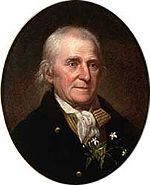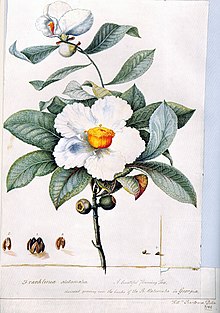|
|
Previous page
Bartram, WilliamFor the Canadian film actor and director, see William Bertram.
| William Bartram |

Portrait of Bartram by Charles Willson Peale
|
| Born |
April 20, 1739(1739-04-20)
Kingsessing, Pennsylvania |
| Died |
July 22, 1823(1823-07-22) (aged 84) |
| Nationality |
American |
| Fields |
naturalist |

Franklinia alatamaha by William Bartram (1782)
William Bartram (April 20, 1739 – July 22, 1823) was an American naturalist and author of the book popularly known as Travels. The son of naturalist John Bartram, William Bartram was born in Kingsessing, Pennsylvania, near Philadelphia. As a boy, he accompanied his father on many of his travels, to the Catskill Mountains, the New Jersey Pine Barrens, New England, and Florida. From his mid teens, Bartram was noted for the quality of his botanic and ornithological drawings. He also had an increasing role in the maintenance of his father's botanic garden, and added many rare species to it.
In 1773, he embarked upon a four-year journey through eight southern colonies. Bartram made many drawings and took notes on the native flora and fauna, and the native American Indians. In 1774, he explored the St. Johns River, where he had memorable encounters with aggressive "crocodiles," and also visited a principal Seminole village at Cuscowilla, where his arrival was celebrated with a great feast. He met Ahaya the Cowkeeper, chief of the Alachua band of the Seminole tribe. When Bartram explained to the Cowkeeper that he was interested in studying the local plants and animals, the chief was amused and began calling him Puc-puggee (the flower hunter). Bartram continued his explorations of the Alachua Savannah, or what is today Payne's Prairie.
[edit] Exploration of the Cherokee Nation
On April 22, 1776 Bartram left Charleston, South Carolina on horseback to explore the Cherokee Nation.[1] After passing through Augusta May 10th,[2] Dartmouth on May 15th (35°19′41″N 82°52′28″W / 35.328003°N 82.874571°W / 35.328003; -82.874571)[3], a few days later he left Fort Prince George and Keowee (34°51′49″N 82°54′06″W / 34.863616°N 82.901575°W / 34.863616; -82.901575) after not being able to procure a guide .[4]
In addition to his botanizing, Bartram aptly described the journey:
- "...all alone in a wild Indian country, a thousand miles from my native land, and a vast distance from any settlements of white people."[5]
- "It was now after noon; I approached a charming vale, amidst sublimely high forests, awful shades! Darkness gathers around, far distant thunder rolls over the trembling hills; the black clouds with august majesty and power, moves slowly forwards, shading regions of towering hills, and threatening all the destructions of a thunderstorm; all around is now still as death, not a whisper is heard, but a total inactivity and silence seems to pervade the earth; the birds afraid to utter a chirrup, and in low tremulous voices take leave of each other, seeking covert and safety; every insect is silenced, and nothing heard but the roaring of the approaching hurricane; the mighty cloud now expands its sable wings, extending from North to South, and is driven irresistibly on by the tumultuous winds, spreading his livid wings around the gloomy concave, armed with terrors of thunder and fiery shafts of lightning; now the lofty forests bend low beneath its fury, their limbs and wavy boughs are tossed about and catch hold of each other; the mountains tremble and seem to reel about, and the ancient hills to be shaken to their foundations: the furious storm sweeps along, smoaking through the vale and over the resounding hills; the face of the earth is obscured by the deluge descending from the firmament, and I am deafened by the din of thunder; the tempestuous scene damps my spirits, and my horse sinks under me at the tremendous peals, as I hasten for the plain."[6]
- "I began to ascend the Jore Mountains, which I at length accomplished, and rested on the most elevated peak; from whence I beheld with rapture and astonishment, a sublimely awful scene of power and magnificence, a world of mountains piled upon mountains. Having contemplated this amazing prospect of grandeur, I descended the pinnacles..."[7](probably Wayah Bald 35°10′49″N 83°33′38″W / 35.1803705°N 83.5604395°W / 35.1803705; -83.5604395)
[edit] Return to Philadelphia
Bartram returned to Philadelphia in January 1777, and assisted his brother John in all aspects of running Bartram's Garden.

Frontispiece and title page of "Travels"
In the late 1780s, he completed the book for which he became most famous, Travels through North and South Carolina, Georgia, East and West Florida, the Cherokee Country, etc.. It was considered at the time to be one of the foremost books on American natural history. Many of Bartram's accounts of historical sites were the earliest records, including the Georgia mound site of Ocmulgee. In addition to his contributions to scientific knowledge, Travels is noted for its original descriptions of the American countryside. Bartram's writing influenced many of the Romantic writers of the day. William Wordsworth, Samuel Taylor Coleridge and François René de Chateaubriand are known to have read the book, and its influence can be seen in many of their works.
Although Bartram has often been characterized as a recluse, all evidence shows that he remained active in commercial, scientific, and intellectual pursuits well into the nineteenth century. He tutored nieces and nephews, penned a number of essays, contributed to several works anonymously, and helped run the family horticultural business. In 1802 Bartram met the school teacher Alexander Wilson and began to teach him the rudiments of ornithology and natural history illustration. Wilson's American Ornithology includes many references to Bartram and the area around Bartram's Garden. Among Bartram's more significant later contributions were the illustrations for his friend Benjamin Smith Barton's explanation of the Linnaean system, Elements of Botany (1803-04).
After the War of 1812, when many of his colleagues, contacts, and friends had died, William Bartram settled into a long period of work, observation and study at the family's garden in Kingsessing. He maintained a "Diary" that records bird migrations, plant life, and the weather. He refused a request to teach botany at the University of Pennsylvania, and in his sixties, declined an invitation from President Thomas Jefferson to accompany an expedition up the Red River in the Louisiana Territory in 1806. He died at his home at the age of 84.
Numerous places and sites are named in his honor:
- The William Bartram Scenic & Historic Highway runs along the east side of the St. Johns River from Jacksonville, Florida south in to northwestern St. Johns County on State Road 13.
- Bartram Trail High School in Switzerland, Florida (just south of Jacksonville.)
- The Bartram Trail is a hiking trail in North Carolina, Georgia, and South Carolina that commemorates his journeys through the area.
- The Bartram Canoe Trail system of canoe and kayak trails in the Mobile-Tensaw River Delta, operated by the Alabama Department of Conservation.
- The William Bartram Arboretum is located within Fort Toulouse Park, near Wetumpka, Alabama.
- Bartram Hall on the University of Florida campus in Gainesville, Florida.
[edit] Bibliography
- Travels through North and South Carolina, Georgia, East and West Florida, the Cherokee Country, etc. Philadelphia, James & Johson, 1791. Modern editions include:
- The Travels of William Bartram: Naturalist’s Edition. ed. Frances Harper. Yale University Press: New Haven, CT, 1958. ISBN 0-8203-2027-7
- William Bartram: Travels and Other Writings. Thomas Slaughter, editor. Library of America, 1996. ISBN 978-1-88301111-6.
- Travels and Other Writings: Travels through North and South Carolina, Georgia, East and West Florida... Ronald E. Latham, editor. Penguin, 1988. ISBN 0140170081
- Travels Through North and South Carolina, Georgia, East and West Florida. University of Virginia Press, 1980. ISBN 081390871X
- William Bartram, 1739-1823: Travels etc. Documenting the American South, University Library, University of North Carolina.
- OELAND, Glenn;
[edit] References
- Bell, Whitfield J., Jr., Patriot-Improvers: Biographical Sketches of Members of the American Philosophical Society, vol. 1, 1743-1768. American Philosophical Society, Philadelphia, 1997, "WIlliam Bartram (1739-1823), p. 414-424.
- Borland, Hal. The Memorable Bartrams. American Heritage Magazine. April, 1975. Volume 26, Issue 3. Accessed March 2, 2007.
- Cashin, Edward J. William Bartram in Georgia. New Georgia Encyclopedia. Accessed March 2, 2007.
- Ewan, Joseph,ed., William Bartram Botanical and Zoological Drawings, 1756-1788. American Philosophical Society, Philadelphia, 1968.
- Fagin, N. Bryllion, William Bartram: Interpreter of the American Landscape. The John Hopkins Press, Baltimore, 1933.
- Hallock, Thomas. From the Fallen Tree: Frontier Narratives, Environmental Politics, and the Roots of a National Pastoral. University of North Carolina Press, 2003.
- Hallock, Thomas and Nancy E. Hoffmann, eds. William Bartram, The Search for Nature’s Design: Selected Art, Letters, and Unpublished Writings. University of Georgia Press, Athens, GA, 2010.
- Harper, Francis, “Travels in Georgia and Florida, 1773-74. A Report to Dr. John Fothergill.” Edited by Francis Harper. Trans. of the American Philosophical Society, n. s. vol. 33, part 2 (November 1943), p. 121-242.
- Braund, Kathryn E. Holland and Charlotte M. Porter, eds. Fields of Vision: Essays on the "Travels" of William Bartram (University of Alabama Press; 2010; 273 pages), essays by scholars
- Lowes, John Livingston, The Road to Xanadu: A Study in the Ways of Imagination. Houghton Mifflin, New York, 1927.
- Magee, Judith, The Art and Science of William Bartram. The Pennsylvania State University Press, University Park, PA, in association with the Natural History Museum, London, 2007.
- Savage, Henry Jr. Discovering America, 1700-1875. p. 63-70. Harper & Row, 1979.
- Waselkov, Gregory A. and Kathryn E. Holland Braund, William Bartram on the Southeastern Indians. University of Nebraska Press, Lincoln, NE, 1995.
- "William Bartram" Dictionary of Literary Biography, Volume 37: American Writers of the Early Republic. Emory Elliot, ed. The Gale Group, 1985, pp. 31-38.
- "William Bartram 1739-1823" Dictionary of American Biography. American Council of Learned Societies, 1928-1936.
- Bartram, William (1980). Travels through North and South Carolina, Georgia, East & West Florida. Charlottesville: University of Virginia Press (by arrangement with The Beehive Press). LCC F213 .B282 1792a. LCCN 73-685 p306
- Bartram, William (1980). Travels through North and South Carolina, Georgia, East & West Florida. Charlottesville: University of Virginia Press (by arrangement with The Beehive Press). LCC F213 .B282 1792a. LCCN 73-685 p318
- Bartram, William (1980). Travels through North and South Carolina, Georgia, East & West Florida. Charlottesville: University of Virginia Press (by arrangement with The Beehive Press). LCC F213 .B282 1792a. LCCN 73-685 p324
- Bartram, William (1980). Travels through North and South Carolina, Georgia, East & West Florida. Charlottesville: University of Virginia Press (by arrangement with The Beehive Press). LCC F213 .B282 1792a. LCCN 73-685 p331
- Bartram, William (1980). Travels through North and South Carolina, Georgia, East & West Florida. University of Georgia Press location=Athens. LCC F213 .B282 1792a. LCCN 73-685 p329
- Bartram, William (1980). Travels through North and South Carolina, Georgia, East & West Florida. Charlottesville: University of Virginia Press (by arrangement with The Beehive Press). LCC F213 .B282 1792a. LCCN 73-685 p341
- Bartram, William (1980). Travels through North and South Carolina, Georgia, East & West Florida. Charlottesville: University of Virginia Press (by arrangement with The Beehive Press). LCC F213 .B282 1792a. LCCN 73-685 p360
- "Author Query". International Plant Names Index. http://www.ipni.org/ipni/authorsearchpage.do.
[edit] Additional information
| Persondata |
| Name |
Bartram, William |
| Alternative names |
W.B. Bartram |
| Short description |
American botanist |
| Date of birth |
April 20, 1739 |
| Place of birth |
Kingsessing, Philadelphia, Pennsylvania |
| Date of death |
July 22, 1823 |
| Place of death |
Kingsessing, Philadelphia, Pennsylvania |
|
Books By This Author
|
|
|